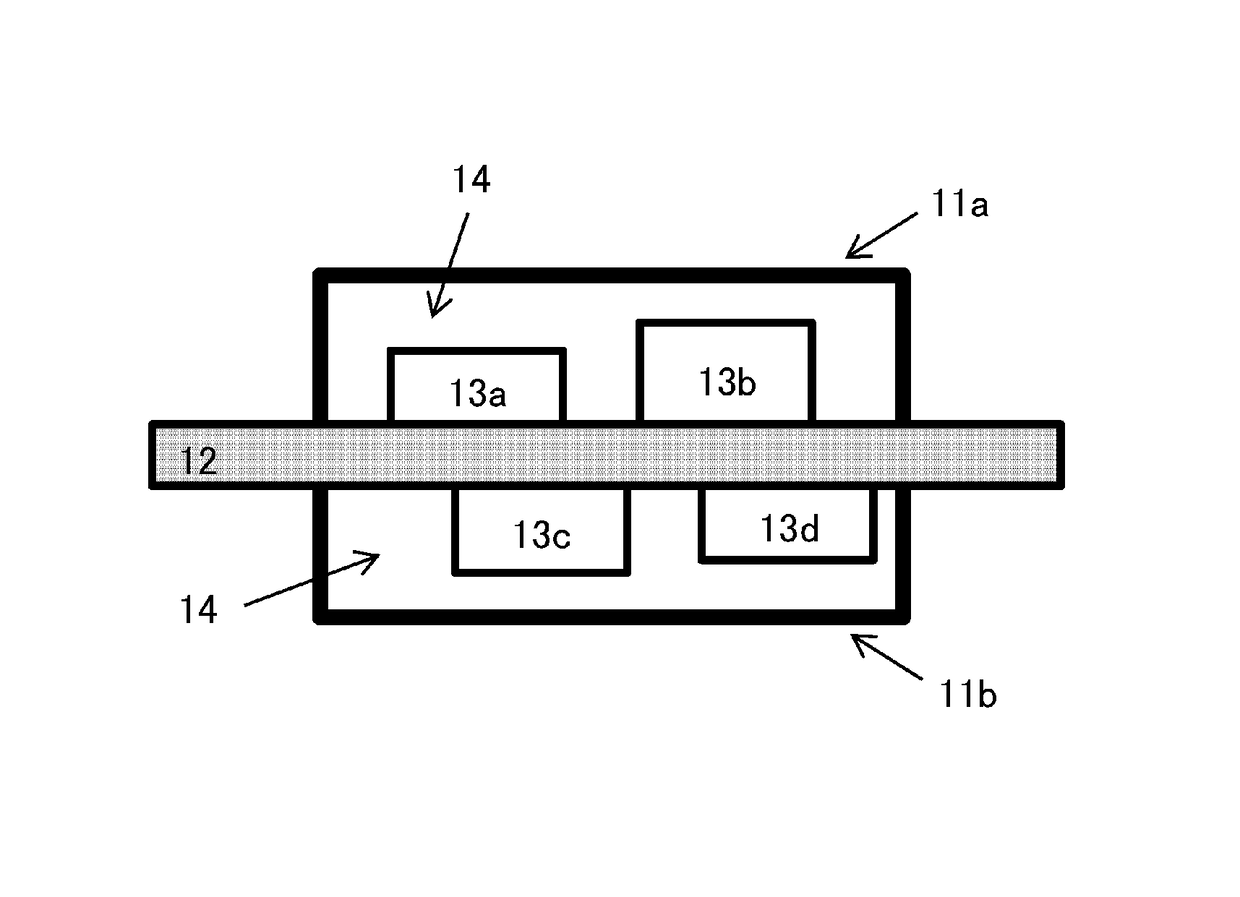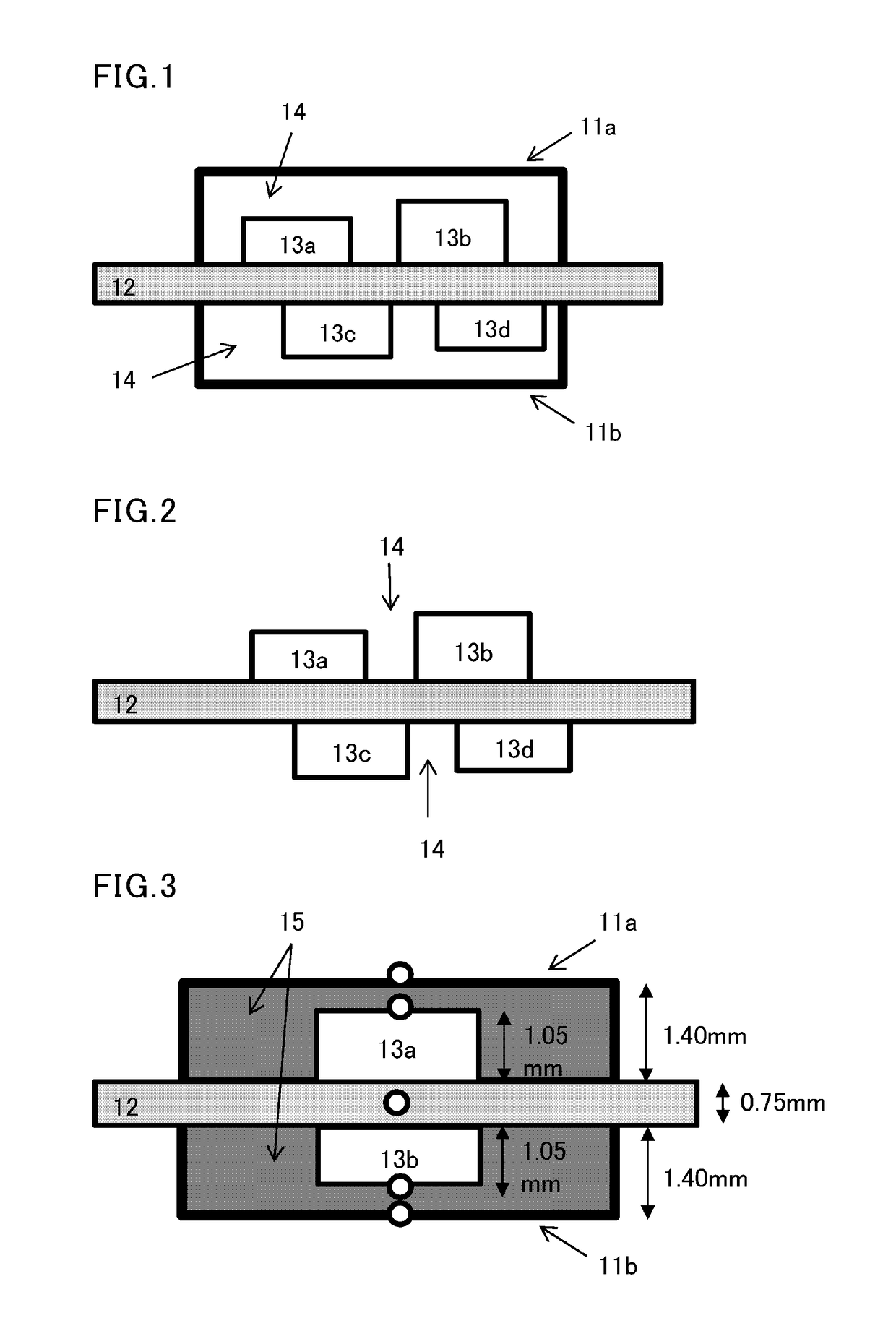Heat dissipating structure
a technology of heat dissipation structure and heat dissipation heat, which is applied in the direction of dielectric characteristics, non-printed electric components association, non-metallic protective coating application, etc., can solve the problems of additional modification work, significant increase in heat generation, damage to electronic components, etc., to prevent overheating of electronic components, prevent deterioration of electronic components performance, and dissipate heat
- Summary
- Abstract
- Description
- Claims
- Application Information
AI Technical Summary
Benefits of technology
Problems solved by technology
Method used
Image
Examples
examples
[0087]The embodiments and effects of the present invention will be explained below with reference to examples which, however, are not intended to limit the scope of the present invention.
(Viscosity of thermally conductive curable liquid resin composition)
[0088]The viscosity of thermally conductive curable liquid resin compositions was measured at 23° C. and 50% RH with a BH viscometer at 2 rpm.
(Thermal conductivity of thermally conductive curable liquid resin composition)
[0089]The thermally conductive curable liquid resin compositions were wrapped in Saran Wrap (registered trademark) and then measured for thermal conductivity at 23° C. using a hot disk thermal conductivity meter (TPA-501 available from Kyoto Electronics Manufacturing Co., Ltd.) by sandwiching a sensor (size: 4φ) between two specimens.
(Tensile elastic modulus of cured product of thermally Conductive Curable Liquid Resin Composition)
[0090]The tensile elastic modulus of mini dumbbell specimens prepared by curing the th...
examples 1 and 2
[0107]The resin (I-1) obtained in Synthesis 1 (90 parts by weight), the resin (I-2) obtained in Synthesis 2 (10 parts by weight), a plasticizer (Monocizer W-7010 available from DIC; 100 parts by weight), an antioxidant (Irganox 1010; 1 part by weight), and thermally conductive fillers (450 parts by weight aluminum hydroxide, and 100 parts by weight zinc oxide) were sufficiently stirred and kneaded by hand. Then the mixture was dehydrated in vacuo while being kneaded under heat with a 5-L butterfly mixer. After completion of the dehydration, the mixture was cooled and mixed with a dehydrating agent (A171; 2 parts by weight) and curing catalysts (tin neodecanoate and neodecanoic acid; 4 parts by weight each). Thus, a thermally conductive curable liquid resin composition was obtained. After the obtained thermally conductive curable liquid resin composition was measured for viscosity and thermal conductivity, the thermally conductive curable liquid resin composition was filled as shown ...
examples 3 and 4
[0112]The evaluation procedure described in Examples 1 and 2 was followed but using a thermally conductive curable silicone resin composition (KE-4918 available from Shin-Etsu Chemical Co., Ltd., paste form, moisture-curable composition, thermal conductivity: 0.9 W / (m·K)) in place of the thermally conductive curable liquid resin composition used in Examples 1 and 2. The evaluation results are shown in Table 1.
[0113]
TABLE 1Examples / Comparative ExamplesComparativeComparativeComparativeComparativeComparativeExample 1Example 1Example 2Example 3Example 2Example 4Example 5Example 3Example 4AmountElectronic1.01.01.01.01.01.01.01.01.0of heatcomponentgeneration13a(W)Electronic0.20.20.20.20.90.90.90.20.9component13bFillingElectromagneticNot filledNot filledFilledFilledNot filledNot filledFilledNot filledNot filledshieldingcase 11aElectromagneticFilledNot filledFilledNot filledFilledNot filledFilledFilledFilledshieldingcase 11bMeasuredElectromagnetic50.450.854.456.454.155.768.150.654.4tem-shie...
PUM
 Login to View More
Login to View More Abstract
Description
Claims
Application Information
 Login to View More
Login to View More - R&D
- Intellectual Property
- Life Sciences
- Materials
- Tech Scout
- Unparalleled Data Quality
- Higher Quality Content
- 60% Fewer Hallucinations
Browse by: Latest US Patents, China's latest patents, Technical Efficacy Thesaurus, Application Domain, Technology Topic, Popular Technical Reports.
© 2025 PatSnap. All rights reserved.Legal|Privacy policy|Modern Slavery Act Transparency Statement|Sitemap|About US| Contact US: help@patsnap.com



